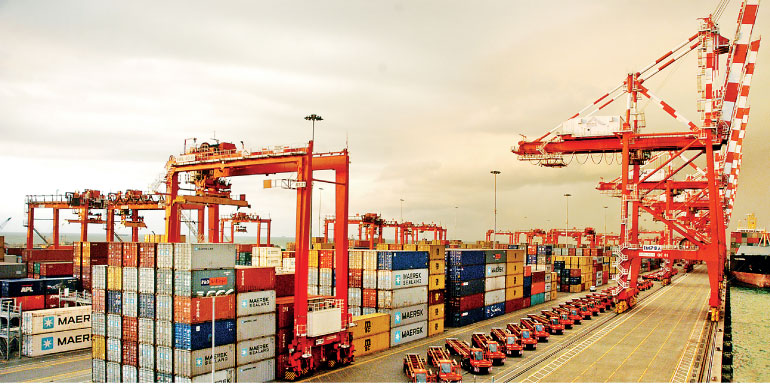Tuesday Dec 16, 2025
Tuesday Dec 16, 2025
Wednesday, 14 June 2017 00:01 - - {{hitsCtrl.values.hits}}
 As GSP plus provides an importer in the EU zero duty benefit on importation of listed goods, Sri Lankan exporters must negotiate favourable export prices for their goods with the buyers
As GSP plus provides an importer in the EU zero duty benefit on importation of listed goods, Sri Lankan exporters must negotiate favourable export prices for their goods with the buyers
At the moment the Sri Lankan business community is optimistic with Sri Lanka regaining GSP plus which the country was deprived of seven years ago. There is much expectation that this would boost the exports of Sri Lanka.
GSP plus confers a benefit to those buyers who import goods listed in Annexure V of the European Union Regulations (928/2012) to the European Union (EU) and does not confer a direct Sri Lankan tax benefit on the Sri Lankan exporters.
As GSP plus provides an importer in the EU zero duty benefit on importation of listed goods, Sri Lankan exporters must negotiate favourable export prices for their goods with the buyers. Though there is no direct impact stemming from the Sri Lankan tax system, the tax policies could play a critical role in deriving the maximum benefit of the GSP plus to the Sri Lankan economy.
Although the listed products would enjoy an EU duty advantage over products from most of the other jurisdictions in to the EU market, there are other nine countries (including Pakistan, Philippines, Armenia, Bolivia, Mongolia, Paraguay, etc.) too enjoying GSP plus status (zero duty). In addition, imports from Least Developed Countries (such as Malawi, Angola, Burkino Faso, Bangladesh, Bhutan, Cambodia, Nepal, Yemen, etc.) also enjoy zero duty status.
Duration of the GSP plus era
The duration for enjoying the GSP plus or the zero duty status in the EU market is not indefinite. Whilst it’s subject to periodical reviews for good behaviour of the country, it is also subject to Sri Lanka reaching ‘Upper Middle Income Status’ i.e. $ 4,306 per capita income. A country recording three successive years of per capita income above the aforesaid threshold would not enjoy the GSP plus status thereafter.
At present, Sri Lanka’s per capita income stands at approximately $ 3,800. If the country reaches the upper middle income threshold as planned by the policymakers of the Government in 2021, with the three-year rule, one could expect the GSP plus status to remain for approximately seven years from to date. Therefore, our exporters should use this interim period as a spring board to enhance exports and equip themselves to face the challenges of the post GSP plus era.
Competitor positions
The largest export sectors for Pakistan are cotton and textiles and the EU is its largest trading partner. Pakistan has been enjoying GSP plus from the year 2014. As a result of GSP+, more than 78% of Pakistan’s exports enter the EU at preferential rates. Textiles and clothing account for over 80% of Pakistan’s exports to the EU. The challenges for Pakistan in reaping the benefits of EU are high costs of doing business, complex regulation and infrastructure bottlenecks.
The Philippines was granted GSP plus in February 2015 and almost 200,000 jobs have been created mainly in agriculture and manufacturing sector thereafter. In the first six months of 2015, Philippine exports to the EU under GSP+ increased by 27%, from Euros 584 million to Euros 743 million. However currently, the European Union is reviewing whether the Philippines can still qualify for trade incentives that are conditional upon compliance with international agreements (especially human rights).
Branding, marketing, quality and capacity
As mentioned earlier, whilst Sri Lankan products would enjoy a duty benefit compared to other jurisdictions, a level playing field would prevail in relation to EU duty for the nine ‘GSP plus Countries’ and ‘Least Developed Countries’ in terms of duty.
What would make Sri Lankan products achieve a competitive edge in this context? Quality of the products, marketing and branding activities in EU and the cost of production in Sri Lanka would play a key role. Invariably there will be a greater demand for Sri Lankan goods in the EU now. To meet the demand there should be enhancement of the capacity. Targeted tax policies should be formulated to assist increase in production to meet the enhanced demand, improve quality, skill development, advertising and branding.
Current income tax incentives for exporters
An analysis of the existing provisions in the current Inland Revenue Act (IRA) reveals that there are many exporter friendly  provisions. It is vital that these provisions are built into the proposed IMF led Inland Revenue Act without diluting the existing tax incentives to the exporters, if the focus is to make Sri Lanka an ‘Export Oriented Country’. Given below are few of the existing exporter friendly income tax incentives in the current Inland Revenue Act.
provisions. It is vital that these provisions are built into the proposed IMF led Inland Revenue Act without diluting the existing tax incentives to the exporters, if the focus is to make Sri Lanka an ‘Export Oriented Country’. Given below are few of the existing exporter friendly income tax incentives in the current Inland Revenue Act.
Branding and advertising of exports
The value of branding has not been comprehended and acknowledged by the Sri Lankan export community. It is building of brands that would achieve sustainable value addition in the long run and not mere exportation of commodities.
The current Inland Revenue Act has acknowledged the same and has provided for a 300% deduction on expenditure incurred by exporters for brand promotion of ‘local brands in international markets’ which is a commendable provision which should be retained in the proposed IMF led Inland Revenue Act too. The current Inland Revenue Act permits deduction of advertising expenditure incurred for export purposes in full (while generally only 75% of advertising expenditure is allowed for non-exporters).
Technology advancement and quality
The quality of products would provide a sustainable competitive advantage for Sri Lankan products in the EU market over products from other competitors. The quality of products would depend on the raw materials used, the skills of the workforce and the use of modern technology in the manufacturing processes. Hence the focused investments in these arenas should be incentivised via the tax policy.
The Inland Revenue Act provides a tax incentive in the form of 50% accelerated depreciation for investment in plant, machinery and equipment for technology upgrade and introduction of any new technology in the business process.
The Budget proposals 2016 pending legislation contained a proposal to provide a qualifying payment relief for the cost of acquisition of any machinery used for canning fruits and vegetables in addition to the depreciation allowance that is normally available as a tax deduction under the law.
Further, a 300% tax deduction is available under the current Inland Revenue Act for research expenses on high value agricultural products. The list of qualified GSP plus exports includes fruits and vegetables such as leeks, carrots, beetroot, lettuce, cucumbers, asparagus, mushroom, capsicum, spinach, salad vegetables, onions, vegetables dried, plantains, banana, pineapple, avocado, lime, melons, durian, papaw, cut flowers and foliage, etc., in addition to other qualified well known products such as apparel and textiles, ceramics, toys, spices, tea and rubber.
Currently, a 300% tax deduction is also available for research expenses expended on product or produce innovation, or improving the quality or character of any product, produce or service.
Capacity increase
To increase the volume of exports, investment in plant and machinery is a pre-requisite. The current Inland Revenue Act provides for benefits for exporters in this aspect too. Whilst, the standard rate of capital allowance for the acquisition of plant and machinery is 33 1/3%, qualified exporter are allowed to claim at the rate of 50% and in the case of large-scale exporters’ at the rate of 100%.
The current Act permits large-scale exporters (investment of more than $ 2 m) setting up a new undertaking to claim the total capital expenditure on plant and machinery as a tax deduction in a single year (100% accelerated depreciation allowance).
The current Inland Revenue Act also provides beneficial treatment in relation to acquisition of capital assets such as plant and machinery by qualifying exporters. The standard rate of capital allowance for those who acquire plant and machinery is 33 1/3% however a beneficial 50% is granted for those who record more than 60% of their turnover from exports.
It is important that the IMF-led Inland Revenue Act should not dilute the capital allowance benefit available to the exporters for acquisition of plant and machinery. If the country is to reap the benefits of the GSP plus status there has to be investment in the plant and machinery by existing exporters and new exporters. This requirement would be felt more in industries such as apparel sector.
Skill training
The current Inland Revenue Act allows for 100% tax deduction of expenses incurred for training. Exporters will welcome a move to provide tax incentivises for training and skill development which would enable them to invest in enhancing the skill levels of their staff.
Impact on exporters in proposed Inland Revenue Act
As pointed out above, the current Inland Revenue Act has recognised the importance of aligning the tax policy of the country to assist the exporters who attract much needed foreign exchange to the Sri Lankan economy. These incentives have been entrenched in to the tax system of Sri Lanka over the years taking in to account the feedback from many stakeholders.
Whilst on one hand policymakers are emphasising on making Sri Lanka an ‘Export Economy’ one should not permit in the guise of enhancing the tax revenue to strike off these salient tax incentives available for the exporters in the much anticipated International Monetary Fund (IMF) led Inland Revenue Act which has been formulated with minimum relevant stakeholder observations.
Exporters of non-traditional goods who enjoyed an income tax rate of 12%, post enactment of the new Inland Revenue Act, will be liable for income tax at the rate of 14%. In addition, apart from the deductibility of the advertising expenditure in total, salient tax incentives available for branding products in the export markets, accelerated depreciation for exporters, training and skill development it seems may not be included in the new proposed Inland Revenue Act.
It is significant to note that the draft of the IMF led Inland Revenue Act contains no specific tax incentives to encourage exporters other than the lower income tax rate of 14% (compared to the standard rate of 28%) granted to a company ‘solely exporting goods and services’.
Under the current Inland Revenue Act a mere 12% income tax rate is applied on the profits and income from exports irrespective of whether the company sells part of the production in the local market. Due to the wording in the proposed Act, those exporters who sell part of their production in the domestic market would be deprived of the lower 14% income tax rate. Accordingly, any exporter who sells part of the production in the domestic market will be liable at 28% on total profits including the exports profits, in the proposed law unless remedial action is taken prior to passing it into legislation.
[The writer, LLB, Attorney at Law, FCMA (UK), is Principal, Tax & Regulatory – KPMG.]